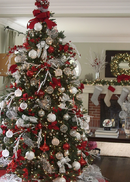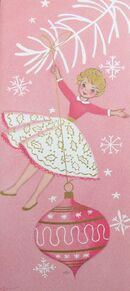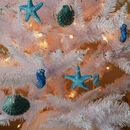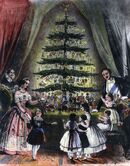Christmas, sometimes abbreviated as Xmas, is an aesthetic which celebrates the general idea of Christmas, the Christian celebration of the birth of Jesus Christ. However, from the Mid 19th century onwards, the aesthetic has distanced itself from strictly religious imagery, and the day is celebrated in a mostly non-religious way. The specific day is on December 25th, but the imagery associated with the holiday appears from November to the end of December.
The visuals associated with Christmas originated from various cultural traditions throughout Western Europe and the United States. As globalization, immigration, and cultural sharing occur, the traditions have been assimilated to a more concrete idea of what is expected at Christmas. This is especially true with the popularity of Christmas-related movies, which communicate the spirit and visuals annually.
The holiday is highly anticipated, as the traditions are associated with nostalgia, goodwill, family, tradition, and happiness. However, as gift-giving is one of the largest traditions of the season, there is an incredible amount of commercialism present in the season, which is addressed in the criticism section.
Colors[]
The colors associated with Christmas are Red, Green, White, and Gold. Here is the meaning behind them:
- Red: Love and the Blood of Christ.
- Green: Hope, Resistance, and Resilience.
- White: Purity, Innocence, and the life of Christ to the World.
- Gold: Light, the Sun, and the presence of the divine. It also represents one of the presents gifted by the Three Magi.
However, in modern times, multiple colors are utilized.
Visual[]
- Angels
- Bells
- Bokeh
- Candy canes
- Christmas trees
- Cookies, especially sugar with icing
- Fairy Lights
- Fireplaces
- Foliage
- Flourishes
- Holly
- Manger scenes
- Mistletoe
- Ornaments
- Pine Cones
- Reindeer
- Snow imagery, such as snowmen, snowflakes, and snow angels
- Stars
- Stockings
- Sparkles
- Toys, specifically recognizable vintage ones such as porcelain dolls, teddy bears, and rocking horses
- Wrapped Presents
- Wreaths
The colors and visuals of Christmas are often used in decoration, furniture, interior design, stock photos/images, advertisement, media, and fashion.
Fashion[]
- Fair Isle sweaters
- Fuzzy socks
- Nightgowns
- Pajamas
- Party clothes
- Plaid skirts and pants
- Santa hats
- Slippers
- Snow boots
- Thick coats
- Ugly Christmas sweaters
Activity[]
- Baking
- Church
- Drinking hot chocolate
- Eating Christmas dinner
- Family gatherings / family activities
- Making gingerbread houses
- Playing with toys
- Singing Christmas carols
- Tree decorating
Substyles[]
Red Christmas[]
It's by far the most common substyle of Christmas seen in most media out there. It's main notable characteristic is the over-abundance of the color Red on backgrounds, decorations, and ornaments. Color pairs like Red & White/Silver, Red & Green, and Red & Gold are very common in this substyle too.
Golden Christmas[]
It focuses on the colors Gold and White, with the absolute lack of any Red. This substyle is sort of a crossover between Christmas and New Year's Eve, the latter which have a very similar color palette and visual motifs, as well as leftover Christmas decoration. And because of that, Golden Christmas gives not only a lighter and more comforting feeling, but also a sense of prosperity and optimism upon an upcoming New Year, in addition of the already stablished key values of Christmas itself. Visual key features of Golden Christmas are the predominant use of the colors Gold, White, Silver, and Green, stars, bokeh, sparkles, flourish patterns, foliage, golden leaves and flowers, and snowflakes. Also, Wood (either painted or not) is used a lot on furniture and interior design in this substyle too.
Dark Golden Christmas[]
It's similar to Golden Christmas, but it uses the color Black instead of White. It gives a darker yet fancier and sophisticated feeling to it, that the usual Golden one doesn't have.
Blue Christmas[]
As the name suggests, it predominantly uses the color Blue, especially Dark and Icy Blue tones, as well as the colors Silver, White, Gold, and Green. Common visual motifs are snowflakes, stars, bokeh, flourishes, and starry night skies. This substyle overall gives a unique "cold night" vibe to the Christmas Holiday.
Green Christmas[]
The color Green is the focus of this substyle, but other colors of Christmas are also used as supporting colors, specially White and Silver. Visual elements of Green Christmas are foliage, pine cones, holly, stars, bokeh, and snowflakes.
Pastel Christmas[]
This is an alternate color scheme for Christmas trees, decor, and food. The most commonly used colors are white, pastel pink, and pastel blue. Retro elements like aluminum (tinsel) Christmas trees are sometimes used. Pastel Christmas also has a distinct cutesy and childish element to it, similar to the Kawaii and Babycore aesthetics.
Winter Christmas[]
It focus on the Winter aspect of Christmas that's commonly portraited on the Northern Hemisphere. Instead of aiming to show the coziness of the interiors seen in Christmas and most of their substyles, Winter Christmas demonstrates the outdoors aspect of the Holiday.
Snowy Christmas[]
Despite the name, unlike Winter Christmas, Snowy is more similar to other substyles like Golden, Blue, and Green, but this one only uses the colors White, Silver, and Green to create a snowy effect on the decoration, ornaments, and images.
Summer Christmas[]
Because of the Southern Hemisphere having "opposite" seasons to the Northern Hemisphere, Christmas in those areas occurs in the Summer. Additionally, some fans of the holiday in the Northern Hemisphere have "Christmas in July." As such, the traditions and visuals associated with the wintertime, such as snowflake decorations, are ironic.
Coastal Christmas[]
This is somewhat related to the Summer Christmas aesthetic, but includes Christmas ornaments that are specifically beach-related, such as seahorses, starfish, and sand-filled glass bulbs. Coloring is usually a cream and aqua, sometimes with a touch of purple.
Victorian Christmas[]
This aesthetic is influenced by British Christmas traditions from the Victorian Era – Christmas stockings with oranges, Christmas crackers, sleigh rides, kissing under mistletoe, going caroling, and trees decorated with cranberries and popcorn. Most of the things associated with Christmas today – such as Santa Claus, Christmas stockings, and gift giving – dates back to the Victorian times.
Note: It's common to see Christmas substyles overlapping and mixing themselves to create more unique and specific styles, so it isn't possible to name everything and some don't have enough information or evidence.
Media[]
Ballet[]
- The Nutcracker
Books/Written Works[]
- A Christmas Carol by Charles Dickens
- A Visit from St. Nicholas by Clement Clarke Moore
- How the Grinch Stole Christmas by Dr. Seuss
- Olive, the Other Reindeer by J. Otto Seibold
- The Adventure of the Blue Carbuncle by Sir Arthur Conan Doyle
- The Christmas Box by Richard Paul Evans
- The Gift of the Magi by O. Henry
- The Polar Express by Chris Van Allsburg
- The Story of Holly and Ivy by Rumer Godden
Movies[]
- A Christmas Carol (many adaptations: 1910, 1923, 1938, 1954, 1984, 1999, 2000, 2004, 2009, 2012)
- Miracle on 34th Street (1947)
- Rudolph the Red-Nosed Reindeer (1964)
- A Charlie Brown Christmas (1965)
- Santa Claus Is Comin' to Town (1970)
- Trading Places (1983)
- A Christmas Story (1983)
- National Lampoon's Christmas Vacation (1989)
- Home Alone (1990)
- The Nightmare Before Christmas (1993)
- The Santa Clause (1994)
- Beauty and the Beast: The Enchanted Christmas (1997)
- How the Grinch Stole Christmas (2000)
- Elf (2003)
- The Polar Express (2004)
- Barbie in A Christmas Carol (2008)
- Last Christmas (2009)
- A Princess for Christmas (2011)
- The Christmas Chronicles (2018)
- Rankin/Bass movies
- Olive, the Other Reindeer (1999)
TV Shows[]
Many TV shows have a Christmas episode which airs during the month of December. See the TVTropes article on "Christmas Episode" for many examples.
Music[]
Traditional[]
Traditional Christmas music includes songs that there are many different covers/versions of. Many of them have Christian themes. These include:
- "Away in a Manger"
- "Deck the Halls"
- "God Rest Ye Merry Gentlemen"
- "Good King Wenceslas"
- "Hark the Herald Angels Sing"
- "Here We Come a-Wassailing"
- "I Saw Three Ships"
- "It Came Upon a Midnight Clear"
- "Joy to the World"
- "O Christmas Tree"
- "O Come, All Ye Faithful"
- "O Come, Emmanuel"
- "O Little Town of Bethlehem"
- "Silent Night"
- "The First Noel"
- "The Holly and the Ivy"
- "What Child is This"
- "We Three Kings"
1940s-50s Christmas Music[]
Modern Christmas music mainly includes songs that are associated with Christmas, despite not having Christian themes. These include:
- "Baby it's Cold Outside"
- "Blue Christmas"
- "Frosty the Snowman"
- "Have Yourself a Merry Little Christmas"
- "It's Beginning to Look a Lot Like Christmas"
- "It's a Marshmallow World"
- "Jingle Bell Rock"
- "Let it Snow! Let it Snow! Let it Snow!"
- "Rudolph the Red-Nose Reindeer"
- "Santa Baby"
- "Santa Claus is Comin' to Town"
- "Silver Bells"
- "Sleigh Ride"
- "Winter Wonderland"
Contemporary Christmas Music[]
- "The Chipmunk Song (Christmas Don't Be Late)" by Ross Bagdasarian
- "All I Want for Christmas Is You" by Mariah Carey
- "Last Christmas" by George Michael
- "Santa Tell Me" by Ariana Grande
- "Wonderful Dream (Holidays Are Coming)" by Melanie Thornton
- "My Only Wish" by Britney Spears
Albums[]
- Christmas With The Rat Pack
Memes[]
- Padoru Padoru
Criticism[]
Christmas is often criticized for the rampant commercialism associated. Rather than focusing on Christianity, family, and kindness, many critics claim that Christmas has become a holiday overly centered on shopping and capitalism.
Some more devout Christians also dislike the increased secularization of Christmas. In their perspective, emphasizing Santa Claus and festivities takes away from the origin of the holiday as Jesus Christ's birth.
Conversely, Christmas may also be alienating to non-Christians. Because of its ubiquity throughout Western culture, Christmas is expected to be celebrated by all citizens, with those not being able to relate to the traditions being seen as sad and unusual.























































































































